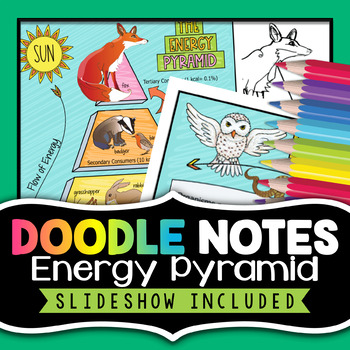Energy Pyramid Doodle Notes - Energy Flow Through Ecosystems
- Zip
What educators are saying
Also included in
- Engaging Life Science Activities for Teens and TweensThis is a massive bundle of my most popular life science resources. This package contains a mix of doodle notes, foldables, color-by-numbers, worksheets, and projects at a BIG SAVINGS!────────────Let's stay connected!⭐ Follow My TPT Store⭐ InstagrPrice $127.00Original Price $178.44Save $51.44
- This bundle includes all of my current and future life science doodle notes. Each activity includes a two-page visual note spread with multiple versions for differentiation and a slideshow presentation. Click the preview to see a closer look.Currently Included in the Bundle:Photosynthesis Doodle NotPrice $32.00Original Price $40.95Save $8.95
- Bundle and save with this energy pyramid activities bundle. This resource contains three activities that will engage students. No prep, just download and go! Click the preview for a closer look.Includes:Energy Pyramid Doodle Notes: This resource is a two-page visual notes sheet regarding the energyPrice $6.50Original Price $9.95Save $3.45
Description
This resource is a two-page doodle notes sheet that focuses on the Energy Pyramid. Students will learn essential vocabulary and create their own energy pyramid. The notes can be organized inside a science interactive notebook. Or, you can have students display their notes on a poster by placing the notes side-by-side.
Why Doodle Notes?
Doodle notes are a form of visual note-taking that embeds brain-based research elements such as dual-coding theory. Dual coding theory emphasizes the use of mental images to aid learning. I include visual memory triggers and coding activities that engage the brain and boost retention throughout my notes.
Included:
- 2-Page Guided Doodle Notes — Fill-in-the-Blank (Color and Black/White)
- 2-Page Blank Doodle Notes — Blank Graphic Organizer (Color and Black/White)
- Teacher Key — Low Ink and Fully Colored
- PowerPoint AND Google™ Slideshow that aligns with the Guided Fill-in-the-Blank Version.
Suggestions for Use:
My doodle notes are so versatile!
You can:
- Use the notes as a science interactive notebook assignment
- Place the notes side-by-side to make a poster
- Complete the notes digitally using TPT Digital Activities
- Use to introduce, reinforce, or review a topic
➤ Plan ahead and get a big discount by buying this activity as part of my Life Science Doodle Notes Bundle
You might also like the following Ecology Activities:
Energy Pyramid - Color By Number
Organisms in their Environment - Color By Number
────────────
Let's stay connected!
────────────
Copyright © Morpho Science
Doodle Notes is a trademarked name used with permission. Please visit doodlenotes.org for more information.








